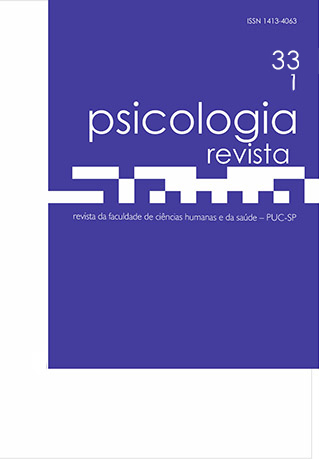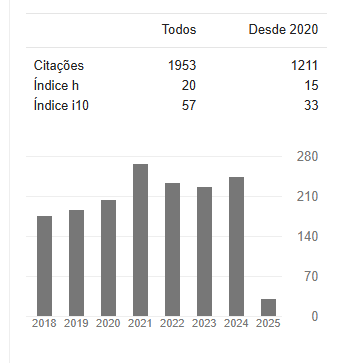#self-mutilation
a study on the representation of self-injury in a virtual community of practitioners
DOI:
https://doi.org/10.23925/2594-3871.2024v33i1p151-177Keywords:
Self-Harm, Nonsuicidal self-injury, NSSI, Social media, Mental healthAbstract
Non-suicidal self-injury is a phenomenon of growing relevance with high prevalence rates in adolescents and young adults. Although they are reluctant to seek professional help, self-injury practitioners have high rates of internet use and online risky behavior, which makes it necessary to investigate the phenomenon in this context. A virtual ethnography was carried out in the Facebook group “self-mutilation” in order to understand how self-injury is treated in a virtual community composed and moderated by practitioners. The contents shared by users in the community were collected and distributed into five categories of analysis: self-injury, suffering, suicide, religion and help. Self-injury is represented in the community as a compulsive behavior with addictive characteristics. Posts of explicit self-injury images generate significantly more engagement than help posts and promote an increase in the number of photos of injuries in subsequent moments. Although the community presents benefits such as the availability of members to talk and provide support, there are a number of harmful aspects such as posts inciting suicide and self-harm, hostility in interactions and unpreparedness to deal with the suffering of others. Finally, the need to develop new intervention strategies in the online environment is highlighted.
References
Ammerman, B. A., Jacobucci, R., Turner, B. J., Dixon-Gordon, K. L., & McCloskey, M. S. (2020). Quantifying the Importance of Lifetime Frequency Versus Number of Methods in Conceptualizing Nonsuicidal Self-Injury Severity. Psychology of Violence, 10(4), 442-451 https://doi.org/10.1037/vio0000263
American Psychiatric Association (2013). Manual Diagnóstico e Estatístico de Transtornos Mentais (5 ª ed.). Arlington, VA: American Psychiatric Publishing
Andover, M. S., Schatten, H. T., Morris, B. W., Holman, C. S., & Miller, I. W. (2017). An intervention for nonsuicidal self-injury in young adults: A pilot randomized controlled trial. Journal of Consulting and Clinical Psychology, 85(6), 620–631. https://doi.org/10.1037/ccp0000206
Arendt, F., Scherr, S., & Romer, D. (2019). Effects of exposure to self-harm on social media: Evidence from a two-wave panel study among young adults. New Media and Society, 21(11–12), 2422–2442. https://doi.org/10.1177/1461444819850106
Brown, R. C., Fischer, T., Goldwich, A. D., Keller, F., Young, R., & Plener, P. L. (2018). #cutting: Non-suicidal self-injury (NSSI) on Instagram. Psychological Medicine, 48(2), 337–346. https://doi.org/10.1017/S0033291717001751
De Riggi, M. E., Lewis, S. P., & Heath, N. L. (2018). Brief report: nonsuicidal self-injury in adolescence: turning to the Internet for support. Counselling Psychology Quarterly, 31(3), 397–405. https://doi.org/10.1080/09515070.2018.1427556
Duggan, J. M., Heath, N. L., Lewis, S. P., & Baxter, A. L. (2012). An Examination of the Scope and Nature of Non-Suicidal Self-Injury Online Activities: Implications for School Mental Health Professionals. School Mental Health, 4(1), 56–67. https://doi.org/10.1007/s12310-011-9065-6
Dyson, M. P., Hartling, L., Shulhan, J., Chisholm, A., Milne, A., Sundar, P., Scott, S. D., & Newton, A. S. (2016). A systematic review of social media use to discuss and view deliberate self-harm acts. PLoS ONE, 11(5), 1–15. https://doi.org/10.1371/journal.pone.0155813
Fitzgerald, J., & Curtis, C. (2017). Non-suicidal self-injury in a New Zealand student population: Demographic and self-harm characteristics. New Zealand Journal of Psychology, 46(3), 156–163. Recuperado de https://researchcommons.waikato.ac.nz/handle/10289/12652
Fonseca, P. H. N., Silva, A. C., Araújo, L. M. C. & Botti, N. C. L. (2018). Autolesão sem intenção suicida entre adolescentes. Arquivos Brasileiros de Psicologia, 70(3), 246–258. Recuperado de http://pepsic.bvsalud.org/scielo.php?script=sci_arttext&pid=S1809-52672018000300017
Gandhi, A., Luyckx, K., Baetens, I., Kiekens, G., Sleuwaegen, E., Berens, A., Maitra, S., & Claes, L. (2018). Age of onset of non-suicidal self-injury in Dutch-speaking adolescents and emerging adults: An event history analysis of pooled data. Comprehensive Psychiatry, 80, 170–178. https://doi.org/10.1016/j.comppsych.2017.10.007
Jones, R., Sharkey, S., Ford, T., Emmens, T., Hewis, E., Smithson, J., Sheaves, B., & Owens, C. (2011). Online discussion forums for young people who self-harm: User views. Psychiatrist, 35(10), 364–368. https://doi.org/10.1192/pb.bp.110.033449
Klonsky, E. D., Victor, S. E., Saffer, B. Y. (2014). Non-suicidal self-injury: What we know, and what we need to know. The Canadian Journal of Psychiatry, 59(11), 565-568. https://doi.org/10.1177/070674371405901101
Lei n° 13.968, de 26 de dezembro de 2019. Alteração do art. 122 do Decreto-Lei nº 2.848, de 7 de dezembro de 1940 (Código Penal). Recuperado de http://www.planalto.gov.br/ccivil_03/_ato2019-2022/2019/lei/L13968.htm
Lewis, S. P., & Seko, Y. (2016). A Double-Edged Sword: A Review of Benefits and Risks of Online Nonsuicidal Self-Injury Activities. Journal of Clinical Psychology, 72(3), 249–262. https://doi.org/10.1002/jclp.22242
Ministério da Saúde. (2017). Perfil epidemiológico das tentativas e óbitos por suicídio no Brasil e a rede de atenção à saúde. In Boletim Suicídio. Saber, agir e prevenir, 48(30), 1–15. Recuperado de https://www.gov.br/saude/pt-br/centrais-de-conteudo/arquivos/2017-025-perfil-epidemiologico-das-tentativas-e-obitos-por-suicidio-no-brasil-e-a-rede-de-aten-ao-a-sa-de-pdf
Otto, S. C., Santos, K. A. (2016). O Tumblr e sua relação com práticas autodestrutivas: o caráter epidemico da autolesão. Psicologia Revista, 25(2), 265–288. Recuperado de https://revistas.pucsp.br/index.php/psicorevista/article/view/24537
Plener, P. L., Kaess, M., Schmahl, C., Pollak, S., Fegert, J. M., & Brown, R. C. (2018). Non-suicidal self-injury in adolescents. Deutsches Arzteblatt International, 115(3), 23–30. https://doi.org/10.3238/arztebl.2018.0023
Silva, A. C. (2016). Comportamento autolesivo não suicida em redes sociais virtuais (Dissertação de Mestrado, Universidade Federal de São João del-Rei). Recuperado de https://pesquisa.bvsalud.org/portal/resource/pt/biblio-1037936
Silva, A. C., & Botti, N. C. L. (2018). Uma investigação sobre automutilação em um grupo da rede social virtual Facebook. SMAD Revista Eletrônica Saúde Mental Álcool e Drogas (Edição Em Português), 14(4), 203–210. https://doi.org/10.11606/issn.1806-6976.smad.2018.000355
Victor, S. E., Muehlenkamp, J. J., Hayes, N. A., Lengel, G. J., Styer, D. M., & Washburn, J. J. (2018). Characterizing gender differences in nonsuicidal self-injury: Evidence from a large clinical sample of adolescents and adults. Comprehensive Psychiatry, 82, 53–60. https://doi.org/10.1016/j.comppsych.2018.01.009
Downloads
Published
How to Cite
Issue
Section
License
Copyright (c) 2023 Felipe Moreira Borges Nascimento Fabbrini, Ivelise Fortim de Campos

This work is licensed under a Creative Commons Attribution 4.0 International License.














